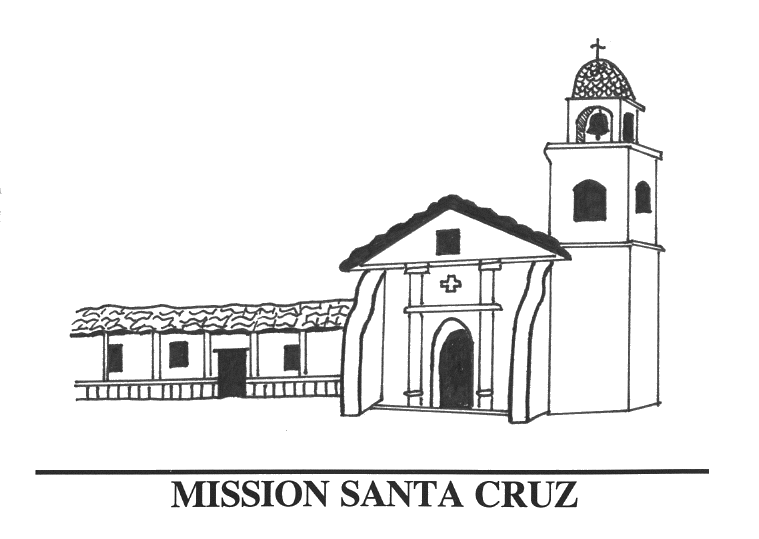| ||||
|
| ||||
|
MISSION
SANTA CRUZ
Corner of High
& Emmet Streets
Santa
Cruz, CA
95060
Established: August 28, 1791
By: Father Fermín Lasuén, Franciscan missionary and successor to Junípero Serra as President of the missions.
Order: 12th of the 21 missions.
Location: 75 miles south of San Francisco, near the mouth of the San Lorenzo River and Monterey Bay.
Named: For the Sacred Cross of Christianity. Full name is Mission la Exaltación de la Santa Cruz.
California Historical Landmark No. 342
DESIGN OF THE MISSION
Church: Destroyed in the mid-1800's. It was 112 feet long, 30 feet wide, 25 feet high, on a three-foot stone foundation; made of adobe with a stone façade (front). Vaulted roof made of redwood beams, first covered with thatch, later with tile.
Style: Little is known about what the church looked like. A painting of the building that hangs in the museum was done after the mission was destroyed, and may not be accurate. Probably there were large stone buttresses on either side of the entrance, to strengthen the walls against earthquake damage. It is likely that redwood was used for beams as it was plentiful nearby. The only drawing of the interior was done the day after the building collapsed from earthquake damage.
Walls: Reported to have been five feet thick.
Bell Tower: The painting shows a square bell tower with a small domed top, attached to the church at the right of the entrance. Records from 1835 mention the existence of ten mission bells, but none of the original bells are there today.
Mission Compound: The quadrangle of buildings around a central patio contained living quarters, workshops, and a two-story granary. Weaving was done at the mission, but the small number of Costanoan Indians here meant that many crafts were not highly developed.
Mission Grounds: A mill for grinding corn and wheat was in operation after 1796, supposedly made from ironworks donated to the mission by the English explorer Captain George Vancouver, who stopped to buy produce in 1794. Crops and livestock flourished, but the mission was never prosperous. Though the site had good soil and plenty of fresh water, its development was hindered by the establishment of a pueblo (town) nearby. Repeated conflicts between the settlers and the mission resulted in the loss of land and goods by the mission.

EARLY HISTORY
1791 Site chosen and blessed on August 28; first services held on September 25. Temporary church of poles and slabs of redwood built near the river.
1793 Site for permanent church moved to higher ground to avoid flooding in rainy season.
1794 Church completed; dedicated May 10
1795 Quadrangle of buildings completed.
1796 Pueblo (town) of Branciforte founded near the mission; among the settlers were criminals given a choice of prison or settling in this town. They did not share the values of the Franciscan fathers.
1811 Church roof replaced with tile.
1818 Under threat of attack by the pirate Hippolyte Bouchard, the Mission residents fled to Soledad Mission, leaving orders for the residents of nearby Branciforte to save the valuables at the mission from the pirates. Bouchard never came, but the townspeople themselves looted the mission.
1825 Church damaged by earthquake.
1830's Large buttresses put on either side of the church front, to strengthen the walls.
1834 Mission secularized, livestock sold and land granted to individuals.
1840 Bell tower collapsed; roof tiles were carried off by local residents.
1857 Earthquake caused the rest of the church to collapse.
1858 Frame church built on the site.
1859 Mission returned to the Catholic Church.
MISSION SANTA CRUZ TODAY
On the site of the old Mission Santa Cruz stands the Holy Cross Church, a white-painted brick, Gothic-style structure with a tall steeple. It bears no resemblance to the mission days, though the bell that hangs in an arch is said to be recast from original mission bells.
Just 200 feet from the original site, however, is a replica , less than half size, of the old mission church, built as a memorial in 1931 by Gladys Sullivan Doyle, who was interested in preserving California history. The concrete exterior of this small chapel has been modeled on as much as is known of the original church, including the square bell tower. There has been less attempt to recreate the interior of the old church, since so little is known. The chapel does have a painting of Our Lady of Guadalupe which dates from 1797 and may have been in the old church. The chapel is used for weddings and other private ceremonies.
A small museum attached to the chapel contains some statues, candlesticks, and paintings from the old mission. In the garden is the original baptismal font carved of local sandstone.
Less than a block away stands the only original structure remaining from Mission Santa Cruz. An adobe building built in 1824 was once thought to have been the soldiers’ barracks. Recent archaeological work indicates, however, that this building housed Indian families at the mission. If so, it is the only mission Indian housing to have survived. This is now a part of the California State Parks system. Rooms in the building have been restored to show how the padres, the natives, and the soldiers lived in the mission days. Tours are conducted by volunteers who dress in the style of the mission period.
